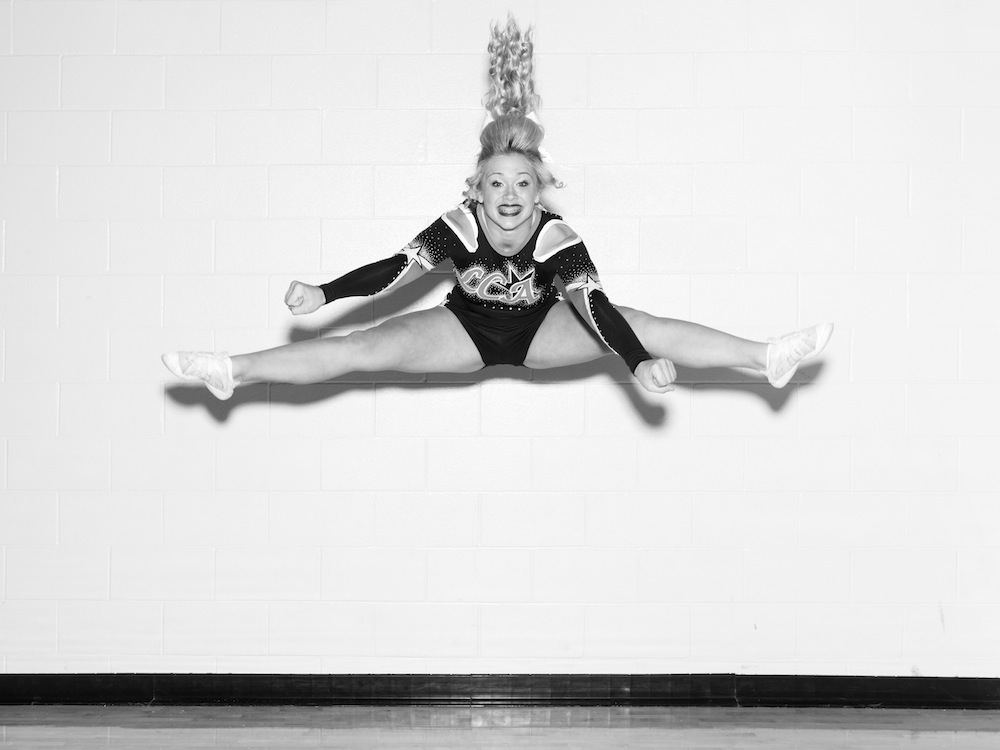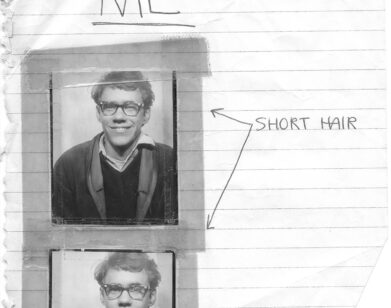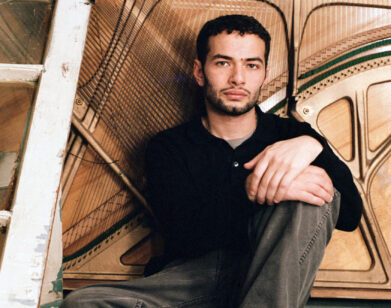The Songs of Alec Soth
ABOVE: ALEC SOTH IN NEW YORK, JANUARY 2015. PORTRAITS BY KATE OWEN. STYLING BY ALPHA VOMERO/SEE MANAGEMENT. PHOTO ASSISTANT: ANDRES ZAWADZKI. GROOMING: LAURA DELEON FOR CHANEL/JOE MANAGEMENT.
Within the layered mythologies of time and place—written, musical, cinematic, or photographic—there are many Americas, overlapping and intermingling, converging and diverging, creating ever-changing histories. The America of photographer Alec Soth, who published his first book Looking for Love in 1996, is often one of stirring loneliness and isolation.
In his meditative bodies of work Sleeping by the Mississippi and Niagara, Soth followed the landscapes (forlorn river banks, snow-dressed fields) and populations (teenagers, prostitutes, preachers) of the titular quantities of water. He pursued those who wished to disappear from the world entirely (monks, hermits, fugitives) in his 2010 series Broken Manual, which brought him to Kentucky and the North Carolina Appalachians.
In 2011, Soth and his friend the journalist Brad Zellar posed as reporters from a fictional local newspaper (Soth even printed fake business cards as credentials) as an experiential birthday gift for Soth, and began investigating a series of happenings in the area around their hometown, Minneapolis. That first trip grew into several, as Soth and Zellar subsequently undertook trips to Ohio, upstate New York, Michigan, Colorado, Texas, Georgia, and California’s Death, Silicon, and San Joaquin Valleys, attending meetings, festivals, and public gatherings, publishing words and pictures from each road trip in the serialized LBM Dispatch, a black-and-white tabloid newspaper distributed by Soth’s experimental imprint, Little Brown Mushroom.
Twenty-five black-and-white photographs made between 2012 and 2014 from Soth’s cross-country travels are featured in a new exhibition, “Songbook,” now on view at Sean Kelly Gallery in New York. The large-scale prints, accompanied by a companion monograph of the same name, draw a lyrical narrative of off-line, real life community, and social life in the sprawl of 21st century America. Rather than a cross-section of the whos and hows of life in the heartland, the immersive series—at times light-hearted, at others heartbreaking—retains a sense of the gap between past and present, and the rituals and attitudes that transcend era or region.
The snow that hit the Northeast earlier this week delayed Soth from beginning the exhibition’s installation on schedule; he began the task via FaceTime from his home in Minnesota. We met with him at Sean Kelly shortly after he landed in New York.
COLLEEN KELSEY: When did you realize that the pictures you were making during these road trips with Brad were going to come together as their own body of work?
ALEC SOTH: It’s a difficult thing to answer because there are so many threads that came together in the making of this work. Before I even started with Brad I was doing some collaborative work with other photographers. Then Brad and I started working together, but just in Minnesota. We didn’t really know it was going to turn into this. I guess it was about halfway through the process of making the Dispatches that I saw, “Okay, this is turning into something larger.” I was making pictures outside of that process, whether it was with collaborative projects or with magazine assignments that were fitting in, in a way. I also knew that I would want this life for the pictures that was outside of the text. In all of my photography from the very beginning, there is this battle between text and image, and how much story to relay. Part of the reason for the name Songbook is this absence of story.
When I think of narrative, I think of storytelling. It’s something I’m fascinated with. I have this publishing company called Little Brown Mushroom, and it’s all about trying to figure out how to use photographs with text to tell stories. But Songbook, in many ways, is about leaving narrative and jumping to the lyrical side of the fence. This work is about community, but there’s something about me that’s always attracted to loneliness and solitude. This is not a happy-go-lucky portrait of society; it’s more of a tug of war between individualism and longing for the social. I struggle to articulate the narrative of it. It’s a bit problematic, like in doing an interview. I’m wary of saying, “It is about this.” I’m happy in the sense that it is open for interpretation. People can talk about the death of social life or whatever; it’s not necessarily how I see it. It’s more musical in that sense, where it’s a feeling about the place I live, slash, who I am in that place.
KELSEY: When I first read the title of Songbook I immediately thought of The Great American Songbook, which is such a canonical encapsulation of the musical culture of a specific moment in American history.
SOTH: I wanted to nudge it in that direction. I have this funny thing I wrote years and years ago on a blog about how I was kind of fed up with books that were titled “American blah blah,” whatever it was. [laughs] So I couldn’t do that, but I wanted to nudge it in that direction. But also I wanted to reference this feeling of nostalgia that’s in the work—talking about contemporary America, but also the way that we hold this history within us, and this nostalgia for time passed. That’s partly how we understand social life, is thinking about our grandparents and what their social life used to be.
One of the really fascinating things about working in this way is that you realize that as much as things have changed, they haven’t changed. Every once in a while I have this revelation like, “Wow, a hundred years ago the world wasn’t black and white.” [laughs] It was in color. Photographed in a certain way, people look from another time. We are just not used to seeing ourselves in that context. Something that’s fascinating about photography is you can isolate a moment, tear it out of its context, and see it afresh. Another realization is that, “Wow, there’s a big world out there, and people are still doing all sorts of the things that they used to do.” There are cowboys. People go to church. We don’t just live in iPad land. [laughs]
KELSEY: What sort of music did you guys listen to on the road?
SOTH: Brad is one of the most knowledgeable people I’ve ever met about music and would generate these incredible playlists for different trips. It was interesting because you can explore a place through this other stratus. There’s all these different ways to see a place. By understanding the music, that’s another way to see a place. That was part of the experience. The name Songbook, the musical element of it, it’s partly conceptual. Because, of course, you don’t crack open the book and music starts playing. You have to think about the music—an idea of music and a soundtrack that you don’t actually hear.
KELSEY: How did the choice to use black-and-white and a snapshot-y method with these photographs affect your formal approach to the work? It’s a change for you, and it definitely accesses that idea of nostalgia.
SOTH: In the very beginning I started working in the way I had in the past, and I realized that wasn’t going to work. It wasn’t fast enough. It wasn’t practical. I quickly realized there’s a reason that press photographers, even with the development of color film, would work in black-and-white and with flash. You can photograph anything. You can be inside, outside, doesn’t matter, you’re controlling the light. It gives you great flexibility. That was a primary motivation. But also, I was making reference to the history of photography and Weegee and that tradition. Lastly was the relationship with the subjects. There’s something more aggressive in the picture making. To work with a large format camera on a tripod, it’s this slow, meditative process. This is: flash in your face, more aggressive. I wanted that. I wanted to be able to change my voice as an author and not always be that soft, meditative onlooker.
KELSEY: How would you describe your relationship with your subjects? Going into a community, a photographer has the role of an outsider or interloper. What has been your experience with people that you meet and want to photograph? Is it sometimes difficult?
SOTH: It’s evolved over the years. I’ve never been the type of photographer to live with people I photograph. You know, shoot heroin with them, that kind of thing. I respect those photographers that work that way. But part of my personality is a certain amount of distance, and part of my attraction to the medium of photography is this distance where you’re in the world, but you’re removed from it. Of course I engage with people, but I like to limit that in some ways. What was great for most of the work that I made is that Brad was with me, he’s talking to people, interviewing them, and I’m left to deal with something else. In the end, pictures are this collection of surfaces, and you’re left to project onto that surface. When I can maintain that in the process of making the pictures, it helps me see the pictures. If I get so wrapped up in the story it’s more difficult. In the editing of Songbook, I really made decisions on the visual subject matter, which is a little different for me.
KELSEY: I read an interview with Brad where he was talking about the immense research that went into going to each location, whether it was history, or folklore, or local current events. After all that preparation, where do you find the element of discovery or surprise that makes a picture?
SOTH: Some of the research plays out, but a lot of it just gives us a destination. We’ll have immense research, historical details, some gravesite that we are going to go see or whatever. But as we’re driving, I will be looking at Yelp for the most interesting restaurant, or whatever. I don’t really care about eating at that restaurant. It’s just to have a place to go. I don’t do well driving totally aimlessly. So many of the pictures just come on the way to finding something else.
KELSEY: How does traveling figure in to your practice?
SOTH: I admire photographers that don’t need a destination. In some ways, street photography is like that. There’s a quality of wanderlust for sure in my work, but I need a destination. I also need the work to be about something. As much as a fan as I am of William Eggleston, for example, I’m not wide open to all things visual, and I’m editing as I go.
KELSEY: Considering how important the medium of the photo book has been for you, how do you see the Songbook work, in terms of narrative and story, contained in the book you’ve produced versus the exhibition here, where the photos are of radically different scale and elicit an entirely different experience?
SOTH: I find myself using music metaphors all the time, but this is too perfect, I feel like. Digital downloading is like photographs online. It’s great, they’re available, you can see lots of different work, but it’s a limited experience of the form. A book is like an album. You don’t have to have a million dollars to be able to buy it, you have to save some money, you have to buy your album, then you take it home, and you put it on your turntable. You look at the liner notes. And you possess it, in a way. That’s what the book is. The exhibition, to me, is like the live show; it’s a selection given the context of the space, the venue, the audience, all that stuff. I will be the first to tell you that my strength is in the book. I know how that functions, just growing up looking at books thinking in those terms. It’s taken me a long time to know how to work in exhibitions and I work with people, curators, or Sean [Kelly], to do it. To use that corny music metaphor, it’s like I was recording in my basement and putting together albums, but then I had to learn to go out on stage. And I realized, “Oh, I need someone to teach me about lighting and how to work the stage.” It’s just a different experience.
SONGBOOK IS ON VIEW UNTIL MARCH 14 AT SEAN KELLY GALLERY, 475 TENTH AVENUE, NEW YORK. SOTH WILL HOLD A BOOK SIGNING OF SONGBOOK SATURDAY, JANUARY 31, FROM 3-6 PM, AND WILL TAKE OVER THE GALLERY’S INSTAGRAM ACCOUNT FOR THE DURATION OF THE INSTALLATION. FOLLOW @SEANKELLYNY OR SEARCH #SKNYTAKEOVER TO SEE SOTH’S IMAGES.







